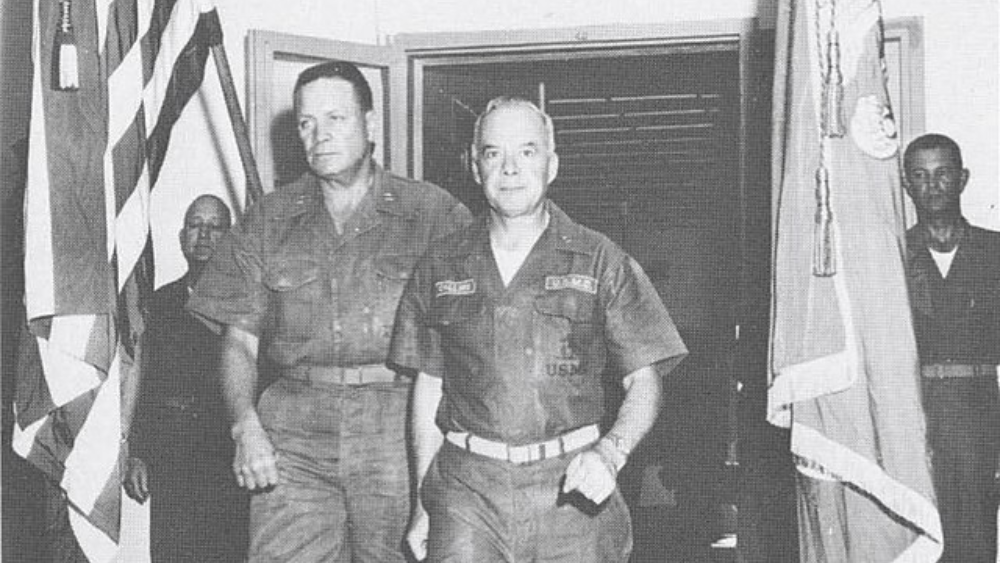General Lewis William Walt stood out as one of the Marine Corps’ most respected officers, with a career that stretched across more than three decades and touched three big conflicts. He held the spot as Assistant Commandant from 1968 until 1971, picking up honors like two Navy Crosses, a Silver Star, and a couple of Purple Hearts along the way. His guts, steady hand in tough spots, and sheer drive made a lasting mark on the military. He’s buried at Arlington National Cemetery in Section 17, Site 51 B, and folks have paid tribute to him there since his passing on May 11, 2000, seeing him as a top-tier Marine.
Roots and First Steps in the Service
Walt came into the world on February 16, 1913, out in Wabaunsee County, Kansas, but spent his growing-up years in Independence, Missouri. He went to Colorado State University, shining in sports and taking charge naturally. Right after finishing up in 1936, he got his commission as a second lieutenant in the Marines, kicking off what turned into an epic run through World War II, Korea, and Vietnam.
World War II: Picking Up That First Navy Cross
In the thick of World War II, Captain Walt made his name fast on the battlefield. He jumped into the Guadalcanal fight in 1942, a real turning point in the Pacific. But Peleliu in 1944? That’s where he really showed what he was made of.
As the guy in charge of the 5th Marines battalion in the 1st Division, he pushed his troops through some nasty Japanese strongholds. Even after getting hit, he stayed right up front, firing up his men against non-stop fire. That kind of nerve got him his first Navy Cross—the Navy’s big nod for battlefield heroics, second only to the Medal of Honor.
Korea: Holding the Line in Brutal Conditions
After the war wrapped, Walt stuck with the Marines and climbed the ladder. When Korea heated up in 1950, he shipped out with the 1st Division. It was a whole different beast: bone-chilling cold, jagged hills, and an enemy that hit and ran like ghosts.
He was front and center in holding the Pusan Perimeter, pulling off the Inchon landing, and the brutal slog at Chosin Reservoir. People took notice of how he kept spirits up and guided his Marines through the worst of it, cementing his rep as a rock-solid leader who didn’t flinch.
Vietnam: Nailing Down a Second Navy Cross
By the mid-60s, as Vietnam ramped up, Walt landed in what might’ve been his toughest gig yet. He got to Vietnam in 1965 and took over the III Marine Amphibious Force, running the show against North Vietnamese troops and Viet Cong fighters.
On top of that, he pushed hard for the Combined Action Program, teaming Marines with South Vietnamese locals to lock down villages and build some real trust. It helped cut into the guerrilla stuff and steady things out in the countryside.
While there, he grabbed his second Navy Cross for straight-up bravery in the heat of it. He’d jump into the danger zones himself, directing ops and backing his Marines personally. That direct approach earned him huge respect among the commanders in the fight.
Stepping Up as Assistant Commandant
Come 1968, Walt moved up to Assistant Commandant, basically the number-two job in the Marines. He focused on updating gear and training to keep pace with how wars were changing, making sure the force stayed sharp and ready for anything.
Moreover, his time there really helped mold the Marines’ future direction. He wrapped up in 1971 and called it a career after over 30 years of hard service.

Walt’s Medals and Recognition
Over the years, Walt racked up a serious collection of hardware:
- Two Navy Crosses for flat-out heroism under fire
- A Silver Star for guts in the fight
- Two Purple Hearts from battle wounds
- Legion of Merit for outstanding leadership and work
- Bronze Star with a “V” for combat valor
All that speaks to his grit and loyalty to the guys beside him.
Life After the Uniform and What He Left Behind
Once retired, Walt didn’t fade away—he kept weighing in on defense issues, penned some pieces on strategy, and gave advice to decision-makers. The Marine crowd held him in high regard, and his thoughts were gold to historians and brass alike.
When he died, on May 11, 2000, a crowd of service members, old comrades, and kin gathered at Arlington to honor his path, laying him in Section 17, Site 51 B.
Wrapping It Up
Lewis William Walt lived out the Marine motto—honor, courage, commitment—like few others. From Pacific islands to Korean ridges and Vietnamese brush, he led with heart and never backed down for his nation. His story still lights a fire under today’s Marines and military folks.
As a heavily decorated vet, Walt’s influence on the Corps is tough to overstate. His efforts and risks won’t be forgotten, putting him right up there with America’s all-time military greats.











Your blog is a constant source of inspiration for me. Your passion for your subject matter is palpable, and it’s clear that you pour your heart and soul into every post. Keep up the incredible work!
Your writing has a way of resonating with me on a deep level. I appreciate the honesty and authenticity you bring to every post. Thank you for sharing your journey with us.
My brother recommended I might like this web site He was totally right This post actually made my day You cannt imagine just how much time I had spent for this information Thanks